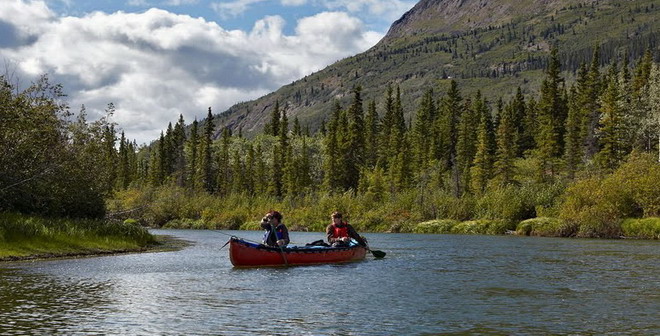CANOEING THE YUKON RIVER


The Yukon River is one of the most iconic rivers in North America and is known for its access to an unspoiled wilderness. It has been etched in history alongside the titanic struggles of the “Stampeder’s” (prospectors) who rushed over the Chilkoot Pass and paddled down the river to stake their claims during the Klondike Gold Rush from 1896-1898. It is a fast flowing river with features including the infamous Five Finger Rapids and Rink Rapids. Although it runs for 1,980 miles, the majority of people start from Whitehorse and travel 460 miles downstream to Dawson City. There are plenty of local outfitters and guides who can help you plan and achieve your journey.
REACHING DAWSON CITY

Paddling the Yukon River and exploring the Five Finger Rapids was another of the highlights and challenges of our trip. The river’s flow is fragmented by large rocky outcrops that provide fair size wave trains, boils and eddies. River right is the safe passage, although as experienced paddlers we confess to spending some time playing.
Dawson City is one of those places everyone should visit at least once in their lifetime, with wooden sidewalks, mud for roads and the worst karaoke in the world! It also holds so much history of our forefathers with the gold rush, Jack London’s cabin and it’s where poet Robert Service wrote much of his work, such as the Spell of the Yukon:
It’s the great, big, broad land ’way up yonder,
It’s the forests where silence has lease;
It’s the beauty that thrills me with wonder,
It’s the stillness that fills me with peace.<
During the gold rush, Dawson was home to over 30,000 people seeking their fortune. There are plenty of places to visit with museums, good food, the old gold dredges and ‘Diamond Tooth Gerties’ music hall and gambling den run by the locals.
TURN LEFT AND JUST KEEP PADDLING
Leaving Whitehorse with our small team was exciting. My brother Mathew, Gordon Ross (our Ghana Ski Team photographer at the Winter Olympics 2010) and friend Aisling Ni Chuinn were ready to explore this mighty river. Compared to many of my previous sea kayaking adventures, paddling the Yukon would be simple – no tides and a moving conveyor belt of water to carry us downstream. Our first day paddling set the tone for the trip with beavers, a massive squall with heavy wind and rain, and then sunshine to warm us at our campsite on Policeman’s Point before tackling Lake Labarge.

Lake Larbarge is a 33-mile, long, shallow lake which can whip up large waves in stormy conditions. We felt privileged and delighted to spot our first grizzly of the trip running along the shore and enjoyed the good weather conditions. The 9 hours days of paddling had become a comfortable routine.
EXPERIENCING THOSE ‘INDIANA JONES’ MOMENTS
One of the incredible elements of paddling the Yukon River is experiencing the living history with old cabins, stern wheelers, old cars and other relics from another time just abandoned in the bush. Hootalinqua, the old shipyard located on an island, provides the opportunity to clamber around the majestic SS Evelyn Norcom, a sternwheeler, that has rested there since 1913. Be aware, Hootlinqua is at the confluence of two rivers (the flow is very fast here). If you don’t ferry glide early enough you will miss it.
One of the reasons I do adventures is that there is a connection with the great outdoors which is truly spiritual. On this adventure we got to canoe for about 30 seconds alongside a young male wolf and spent 10 minutes canoeing down the Yukon next to a black bear swimming in the flow. Those moments truly touched us and were a stark contrast from the pace of modern life.
Pelly Crossing, the confluence of the Yukon and Pelly Rivers at a First Nation Settlement called Fort Selkirk, was one of the highlights of our trip. It is rich in heritage as the buildings have been preserved by the hard work of a few locals and interpreters who are also based there and will tell you about the history. Wandering around Dury Stores and the old church was really poignant and moving. We found similar feelings and experiences on many occasions climbing over old Ford cars and heavy equipment that was just abandoned. Fort Selkirk was also home to the Van Bibber Family who contributed so much to the Yukon Archives. Alex Van Bibber led a 500 mile expedition through the Mackensie Mountain Range, which I plan to repeat in 2015. (Ski to the Edge).
‘FALLING OFF THE FACE OF THE EARTH’

Leaving Dawson is said to be like falling off the face of the earth. The speed of the river picks up again to almost 7 mph and there are less people. Our next target was Eagle, the border crossing into the U.S. and a place to restock and get a shower. Beyond Eagle, we entered the Charlie Yukon National Reserve and parked ourselves on the Rock of Ages, a 4,000 year old stalagmite in the middle of the Yukon river. We also passed Calico Bluff, a stunning, huge limestone and colored shale escarpment.
We finished canoeing the Yukon in Circle Alaska, just South of the Arctic Circle at Fort Yukon. By now, the Yukon had earned its name Land of the Midnight Sun, with almost 24 hours of light. We were happy to reach our goal, and when we put in found the place deserted. We departed Circle close to the hot springs via a narrow mountain pass road which provided one final bit of excitement.
This trip left me cativated by the magic of the Yukon and I have since returned to complete two more adventures.


